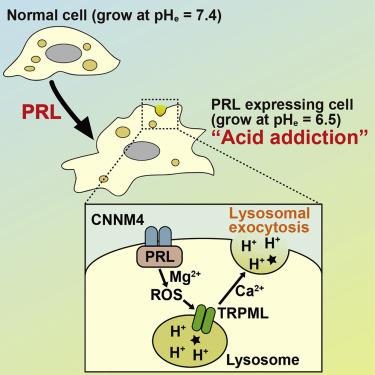Developmental Cell ( IF 11.8 ) Pub Date : 2020-09-11 , DOI: 10.1016/j.devcel.2020.08.009 Yosuke Funato 1 , Atsushi Yoshida 1 , Yusuke Hirata 2 , Osamu Hashizume 1 , Daisuke Yamazaki 1 , Hiroaki Miki 1

|
Extracellular pH is usually maintained around 7.4 in multicellular organisms, and cells are optimized to proliferate under this condition. Here, we find cells can adapt to a more acidic pH of 6.5 and become addicted to this acidic microenvironment by expressing phosphatase of regenerating liver (PRL), a driver of cancer malignancy. Genome-scale CRISPR-Cas9 knockout screening and subsequent analyses revealed that PRL promotes H+ extrusion and acid addiction by stimulating lysosomal exocytosis. Further experiments using cultured cells and Caenorhabditis elegans clarified the molecular link between PRL and lysosomal exocytosis across species, involving activation of lysosomal Ca2+ channel TRPML by ROS. Indeed, disruption of TRPML in cancer cells abolished PRL-stimulated lysosomal exocytosis, acid addiction, and metastasis. Thus, PRL is the molecular switch turning cells addicted to an acidic condition, which should benefit cancer cells to thrive in an acidic tumor microenvironment.
中文翻译:

致癌的PRL蛋白通过刺激溶酶体胞吐作用导致细胞酸成瘾。
在多细胞生物中,细胞外pH通常保持在7.4左右,并且细胞经过优化可以在这种条件下增殖。在这里,我们发现细胞可以通过表达再生肝的磷酸酶(PRL)(一种恶性肿瘤的驱动因素)来适应更酸性的6.5 pH并沉迷于这种酸性微环境。基因组规模的CRISPR-Cas9基因敲除筛选和后续分析表明,PRL通过刺激溶酶体胞吐作用促进H +挤出和酸成瘾。使用培养的细胞和秀丽隐杆线虫的进一步实验阐明了PRL和跨物种的溶酶体胞吐作用之间的分子联系,包括溶酶体Ca 2+通道TRPML的激活。确实,TRPML的中断癌细胞消除了PRL刺激的溶酶体胞吐作用,酸成瘾和转移。因此,PRL是使分子沉迷于酸性条件的分子开关转向细胞,它应该使癌细胞在酸性肿瘤微环境中壮成长。



























 京公网安备 11010802027423号
京公网安备 11010802027423号